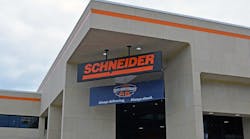Feeding time
The Federal Reserve continues to be concerned about inflation even though inflation remains in the 3% range. That level of inflation is not detrimental to the economy nor to most consumers' pocketbooks. Truck equipment builders and buyers should be so lucky.
Recently, steel prices posted increases of nearly 100% over year-ago levels. Availability of specialty steel for gears and related parts is also at issue. Once a full economic recovery is under way, here and abroad, steel shortages as well as price spikes are likely.
Indeed, after three to four years of modest price increases, the commercial vehicle market had better get braced for significant changes shortly-and continuing for the next two years.
There are several factors that will cause the likely surge in prices. For one, component suppliers have been unable to gain the price increases needed to sustain investment and product development costs over the past three years. This is not unusual when a market suffers a slowdown and pricing becomes very competitive. The problem is further complicated by the need to invest in new products to meet the regulatory changes that have been put into effect.
Most market observers feel the only component affected was the engine with some slight modification required for the exhaust system. Not really. To optimize operating performance using the newer engines, other drivetrain components had to be modified. These changes were often not fully understood until engine performance had stabilized. The bottom line is that a significant retooling and engineering effort was required to meet the new emissions requirements.
Within the engine compartment, there were changes to the fuel system, cooling system, and electronic controls. Not only was there a need for significant tooling and design changes by truck OEMs, but each component manufacturer had to be on board to make the necessary changes to their components for the system to function properly. There were no development funds set aside to meet these requirements, so the funds had to come from reserves. Keep in mind this happened at a time when overall demand was lower due to an economic downturn, as well as aggressive purchasing in the late 1990s.
Truck manufacturers had to completely redesign the engine compartment and, to a lesser degree, electronic monitoring systems. At each step of the way, OEMs used their economic clout to keep prices in line by holding component price increases at bay and by becoming more efficient in their own processes. There is no system I am aware of that can perpetually reduce costs while making changes to the final product that are very cost consuming.
The commercial vehicle market, covering GVW Class 6-8, will swing from a production level of approximately 300,000 for calendar-year 2003 to a level of nearly 500,000 for 2005. The dis-economies of scale for that amount of output variation is very costly to all concerned in the manufacturing process, from specialized bearing makers to cab producers. Each suffers its own cost disruptions and have to be fairly compensated if we are to continue to expect high quality..
Finally, our market does not act in a vacuum. So, as the rest of the world gains footing and starts to expand, there will be more pressure on supply and thus an impact on prices for all industrial goods.
The bottom line is that the bottom line has to be fed. And it will be with price increases that will be rather unsettling. Carriers need to be prepared to meet these coming increases. That means knowing their operating costs as never before — so they are able to plan for equipment turns and profitable operations.


